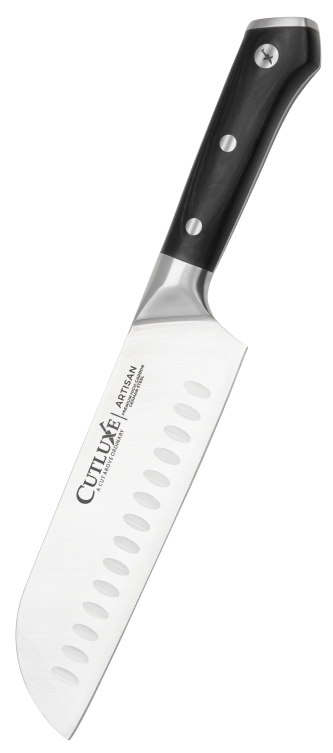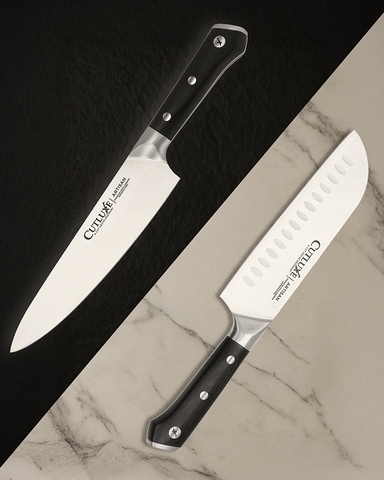The Everyday Kitchen Dilemma
If you're serious about your cooking or even just trying to upgrade from that dull old blade, you’ve likely asked yourself: Should I get a chef’s knife or a santoku? These two knives are staples in both professional and home kitchens, and for good reason. They’re versatile, reliable, and built to tackle a wide range of everyday prep.
But choosing the right knife isn’t about trends; it’s about how you cook. Both the santoku and the chef’s knife shine in different situations, depending on your cutting technique, your preferred ingredients, and how you like your tools to feel in your hand. So, let’s break down how these knives are used differently and figure out which knife deserves that prime spot on your countertop.
Santoku Knife vs Chef Knife – Key Differences Explained
Both chef knives and santoku knives are multi-purpose kitchen tools, but they stem from very different culinary traditions. The chef’s knife comes from Western cuisine, built for power and versatility. The santoku, with its Japanese roots, was designed for balance and precision in tighter spaces, perfect for slicing delicate fish, vegetables, and boneless meat.

- Ultra-sharp performance
- Precision chopping power
- Full tang control
- Includes protective sheath
- Rust-resistant German steel
- Versatile kitchen essential
- Ergonomic pakkawood handle
- Clean, smooth slices
- Durable forged blade
- Lifetime warranty backed
Blade Shape and Size Comparison
The chef’s knife typically has a longer blade (usually 8–10 inches) with a curved edge that allows for a rocking motion. The santoku, on the other hand, is shorter (usually around 7 inches) and features a flatter edge and sheepfold tip. This shape lends itself to quick, straight-down chopping. Both knives handle various tasks, from slicing vegetables to cutting through tender meat, making them essential for preparing all kinds of meat dishes.
Santoku knives often include a granton edge—those small divots along the blade—that help prevent food from sticking while slicing. Chef knives, with their longer blade and pronounced curves, are better suited for rocking through herbs, garlic, or larger pieces of meat. Each knife’s blade design reflects how it is used for specific cutting styles and the tasks it handles best.
Cutting Techniques and Comfort
Comfort comes down to your knives grip and style. If you prefer rocking your blade, the chef’s knife is your go-to. If you favor a precise, up-and-down motion, the santoku might feel more natural.
Beginners often find santoku knives easier to control due to their shorter length and lighter weight. On the flip side, experienced chefs often lean toward the classic chef knife for its adaptability across prep tasks. Choosing the right knife for your cutting style can make all the difference in comfort and efficiency, especially when used with different types of meat.
What Is a Santoku Knife and What Is It Used For?
The word “santoku” means “three virtues” in Japanese, referring to its skill at slicing, dicing, and mincing. True to its name, the santoku knife excels in all three, making it a must-have for those who appreciate simplicity and precision in the kitchen.
Rooted in Japanese culinary tradition, the santoku knife is known for its clean cuts, light feel, and balanced design. While originally developed for fish and vegetables, modern santoku knives are now incredibly versatile, capable of handling everything from sushi to chicken thighs and various meat preparations. This knife is used in many kitchens worldwide and makes a noticeable difference in how cooks execute a variety of techniques with ease and confidence.
Using a Santoku Knife for Everyday Prep
If you're prepping fruits, slicing cheese, or finely chopping herbs, the santoku knives provide control and elegance. Their design makes a noticeable difference in repetitive tasks where you want consistency in every cut. The santoku knife’s balance and sharp edge help reduce fatigue during extended prep sessions. Among Cutluxe’s knives, it stands out for its versatility and ease of use in everyday cooking.
Santoku Knife for Meat and Vegetables
Though it’s not meant for heavy-duty butchering, a well-made santoku knife like those from Cutluxe can glide through boneless meat, root vegetables, and even soft tomatoes without squashing or tearing. It’s especially handy when preparing stir-fries or dishes with finely chopped ingredients. This knife’s versatility makes it a reliable tool for a variety of kitchen tasks involving both meat and produce. Many home cooks and professionals alike have used santoku knives to achieve precise, clean cuts every time.
Chef’s Knife Shapes and When to Use Them
The chef’s knife is often called the “workhorse” of the kitchen, and for good reason. It’s built to do it all: slice, chop, dice, mince, and carve. With its signature curved blade and pointed tip, it offers both power and precision. A well-balanced chef’s knife makes a difference by allowing cooks to move seamlessly between tasks, making it indispensable for any kitchen.
Classic vs Modern Chef Knife Designs
Classic chef knives feature a pronounced curve, ideal for the rocking chop technique. Modern designs—like those knives from Cutluxe—optimize weight distribution and blade geometry to increase control without sacrificing force. Materials like high-carbon German stainless steel ensure durability of your knives across prep styles. Each knife is crafted to balance strength and agility, making it a trusted tool for every kitchen task.
When a Chef Knife Outperforms Santoku
There are times when the chef’s knife just does more. If you're breaking down large cuts of meat, tackling dense vegetables like squash, or making long slicing motions through brisket or fish, the length and strength of the chef’s knife give it a clear edge. Its heavier build and pronounced blade curve also help with high-volume cooking or professional prep, where speed and momentum are key. Among kitchen knives, the chef’s knife stands out for handling the toughest tasks with ease, making a real difference in the kitchen.
Chefs often rely on a variety of knives in their toolkit, but when it comes to heavy-duty tasks, the chef’s knife stands out among other knives for its power and versatility.











